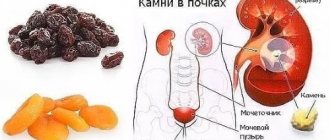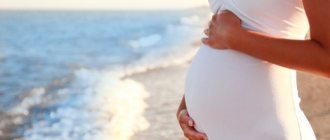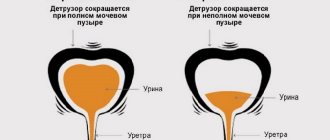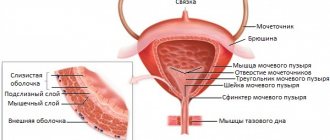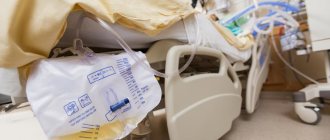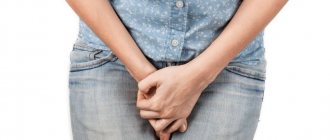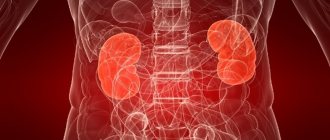Overactive bladder is not a disease, but represents a whole complex of symptoms that usually accompanies various pathologies of the urinary organs and nervous system. Symptoms of OAB (as the syndrome is called for short) are reduced to an increased urge to urinate, urge urinary incontinence, and nocturia.
A reactive bladder is a phenomenon caused by increased sensitivity of receptors to stretching and increased contractile activity of the detrusor, this is precisely the root cause, and it is already provoked by other internal and external factors. Detrusor contractions cannot be suppressed by volitional efforts, hence urinary incontinence.
Epidemiology
OAB is considered a severe urinary disorder. After 40 years, it occurs in at least 17% of the population, among them 44% of men and 56% of women. In Europe, about 22 million people suffer from hyperactive bladder, but only about 27% of them are treated. This is due to the underestimation of the problem by patients and doctors themselves.
With age, the frequency of OAB increases. After 60 years, symptoms of the disease are detected in 30% of the population, after 70 already in 40%.
The disease, which occurs with urgency and frequent urination, is equally common among both sexes. But urinary incontinence is more typical for older women, which most patients associate with the onset of menopause.
Pharmacotherapy
Pharmacotherapy is a fairly effective method of treatment; it involves the prescription of drugs from the following groups:
- 1M anticholinergics: oxybutynin (driptan), tolterodine (detrusitol), trospium chloride (spazmex), etc. These drugs are often prescribed, but have many side effects. It is noteworthy that trospium chloride is the only drug in the group that does not penetrate the blood-brain barrier, which means it has a minimum of side effects.
- 2 In addition to the drugs of the first group, it is possible to prescribe antispasmodics and calcium channel blockers (verapamil, diltiazem).
- 3In combination with M-anticholinergics, the use of tricyclic antidepressants (imipramine) is also possible.
If drug therapy is ineffective, local injection of botulinum toxin into the detrusor and intravesical administration of capsaicin are possible.
Botulinum toxin blocks the release of neurotransmitters, resulting in gradual relaxation of the detrusor muscle. Repeated administrations of the drug are necessary every 3-12 months, depending on the type of toxin and the degree of individual sensitivity to it.
The therapeutic effect of capsaicin is based on the extreme irritation of the nerve endings located inside the bladder wall. Their overstimulation leads to inhibition of detrusor activity.
7.1. Assessing the effectiveness of drug therapy
The effectiveness of the treatment is assessed on the basis of a decrease in the severity of symptoms and an improvement in the general condition of patients.
The initial effect of the use of M-anticholinergics is recorded within 1-2 weeks, but the maximum effect is observed approximately 5-8 weeks of treatment.
That is why drugs are used for a long time. In most clinical cases, after discontinuation of drugs, a relapse of symptoms is observed.
To reduce the likelihood of adverse reactions, forms with a slow release of the active substance, including transdermal ones (plasters), began to be used.
Causes
The exact mechanism of development of overactive bladder is not fully understood. Scientists adhere to two theories about the origin of the disease.
The first is neurogenic, it is associated with disorders affecting the supraspinal centers of the nervous system and the conducting nerve fibers of the spinal cord.
In turn, this leads to deterioration of blood circulation in the brain, multiple sclerosis, and spinal injury.
Non-neurogenic mechanisms of bladder hyperactivity are caused by age-related processes in the detrusor, a complex of muscles that controls urination.
The problem may also be due to anatomical changes in the location of the bladder and urethra or ifravesical obstruction.
Among the causes of the development of pathology, the most likely are:
- Traumatic brain injuries.
- Hemorrhages in the brain.
- Tumors, bruises and hernias of the spinal cord.
- In men, prostate tumors.
- Chemical poisoning, including drug overdose.
- Diabetes.
- Complications after operations on the spinal cord and urinary organs.
- Congenital anomalies of the development of the urethra.
- Stroke.
OAB often accompanies mental retardation and is one of the signs of dementia.
There are a number of factors under the influence of which the likelihood of developing pathology increases, these are:
- Age. As the body ages, the capacity of the bladder cavity decreases and the rate of urine output decreases, as well as changes in the nervous and vascular systems.
- Smoking. Nicotine has a negative effect on detrusor contraction and an antiestrogenic effect (in women) on the urethra and bladder. Long-term smoking also disrupts the synthesis of collagen, which ensures the elasticity of muscle fibers.
- Obesity. Excess weight provokes an increase in pressure, both in the cavity of the bladder and in the entire abdominal cavity. As a result, there is a continuous irritating effect on the nerve endings innervating the pelvic organs, that is, the bladder is constantly in a hyperactive phase.
- Poor nutrition. Insufficient consumption of plant fruits rich in fiber provokes constipation, which consequently leads to stretching of the large intestine. And this, in turn, negatively affects the functioning of the nervous system, which ensures the normal functioning of the pelvic organs. An overactive bladder is also typical for those who prefer to eat cattle meat. It contains a lot of animal fats, under the influence of which hyperlipidemia occurs, provoking vascular atherosclerosis and ischemia of individual organs.
- Urinary infections. When the bladder is infected, in half of the cases patients complain of urinary incontinence. If the inflammation becomes recurrent, then there is a high probability of constant irritation of the receptors of the mucous layer of the bladder. As a result, this leads to an increase in the pathological sensitivity of the walls of the organ.
- Hormonal disbalance. In postmenopausal women, bladder overactivity is associated with decreased estrogen production.
POPULAR WITH READERS: Kidney cyst, causes, symptoms, treatment
OAB in people under 40 years of age is detected relatively rarely. But hyperactivity is often diagnosed in children, but the causes of pathology at an early age are for the most part completely different, these are:
- Peculiarities of the child's temperament - OAB is more common in hyperactive children.
- Congenital anomalies of the development of the urinary organs.
- Severe and prolonged stress.
- Excessive intake of liquids.
Uncontrolled urination is considered normal until the age of 3-4 years. But if the problem is detected in adolescents, then it is advisable to undergo an examination as early as possible, since a hyperactive bladder can be one of the symptoms of mental illness.
Correct diagnosis will improve quality of life
Diagnosing the causes of overactive bladder is critical to the patient's quality of life.
To make a correct diagnosis, the doctor uses the following methods:
- History: includes a conversation with the patient about the clinical history of the disease. The patient is asked whether he has had episodes of urinary incontinence, how many times he gets up at night, whether he often feels an urgent need to urinate, whether he has time to get to the toilet, or whether involuntary losses occur.
- Examination: carried out by examining the abdominal cavity and genitourinary apparatus. In women, a pelvic examination is performed to look at the condition of the pelvic floor muscles; in men, a prostate examination is performed.
- Level 1 tests: necessary for differential diagnosis with diseases such as cystitis, irritable bowel syndrome, urinary tract infections and the presence of bladder or kidney stones.
- Urodynamic test: Used to evaluate the filling and emptying of the bladder to rule out urinary stasis (meaning the bladder does not empty completely during urination), which can lead to symptoms similar to overactive bladder syndrome. This test can be combined with uroflowmetry, which evaluates the volume and flow rate of urine.
- Other level 2 tests: to rule out dangerous diseases such as tumors in the bladder or changes in muscle contractility. These studies include cystometry, electromyography and urethrocystoscopy.
Classification of GMF
Due to its development, overactive bladder is divided into 2 types:
- Idiopathic – the main causative factor of the disease cannot be determined.
- Neurogenic – the causes of the pathology are associated with malfunctions of the central nervous system.
According to the clinical picture, hyperactivity can be:
- Wet. The need to urgently empty the bladder is accompanied by involuntary leakage of urine.
- Dry. The frequency of urination is increased, but there is no urinary incontinence.
Etiological factors and causes
All causative factors for the development of a hyperreactive bladder are divided into two types:
- Neurogenic,
- Not neurogenic.
The first group of pathologies includes all conditions that can lead to deterioration of the innervation of the bladder:
- Parkinsonism,
- Alzheimer's disease,
- Hemorrhagic or ischemic stroke,
- Multiple sclerosis,
- Osteocondritis of the spine,
- Intervertebral hernia,
- Spondyloarthrosis,
- Traumatic spinal cord injuries,
- Complications arising after spinal surgery.
Symptoms
The main sign of an overactive bladder is frequent urination up to 10-15 or more times a day, not associated with excessive fluid intake and diuretic medications.
In addition to the main symptom, the disease manifests itself:
- Nocturia – urination at night up to 2 or more times.
- An urgent urge to empty the bladder, which may occur unexpectedly for the patient, including in inconvenient places, for example in transport.
- Urgent incontinence.
Despite the strong, uncontrollable urge to urinate, little urine is almost always released when visiting the toilet. If OAB develops against the background of a urinary tract infection, then pain in the lower abdomen, burning in the urethra, and fever are possible. The pathology may periodically worsen and subside.
Range of additional studies
Additional studies are prescribed in the following cases:
- 1Hematuria (appearance of blood in the urine) in the absence of infectious and inflammatory diseases;
- 2Difficulty urinating;
- 3 Signs of neurological disorders;
- 4Symptoms of metabolic disorders;
- 5 Lack of positive dynamics after 2-3 months of therapy.
The only method that allows you to definitively confirm the diagnosis is a comprehensive urodynamic study (CUDI), which includes:
- 1 Cystometry - measuring the level of bladder pressure when it is filled;
- 2 Determination of the level of pressure in the urethra;
- 3Uroflowmetry - measurement of urination rate;
- 4Study of electrical activity (electromyography) of the pelvic floor muscles.
Carrying out CUDI is possible only in large urological clinics, but the data obtained allow the urologist to accurately determine the cause of hyperactivity.
Diagnostic methods
Patients with suspected OAB are initially examined by a urologist. The doctor first carefully collects an anamnesis of the disease - finds out how many times urination occurs per day and per night, how often the sudden urge to empty the bladder bothers you, how much urine is produced. It is necessary to clarify whether there is urine incontinence during laughter, coughing, or physical activity.
At the appointment, the patient is examined. Men are shown a rectal examination of the rectum to detect changes in the prostate gland.
Laboratory diagnostics include general urine analysis and Nechiporenko analysis. The main purpose of their implementation is to identify deviations in indicators. With true OAB, there are no significant changes in the urine.
A large number of leukocytes and hematuria indicate that the patient needs an extensive diagnostic examination, on the basis of which it will be possible to exclude infectious and inflammatory diseases, neoplasms, and urolithiasis.
It is necessary to take a blood sugar test, as the cause of the disease may be developing diabetes mellitus.
Among the instrumental examination methods used:
- Cystoscopy. An endoscopic examination of the lower urinary tract is carried out to identify changes in the mucous membrane of the urethra and bladder.
- Ultrasound. Sonography shows structural changes in the kidneys, prostate in men, and bladder. Ultrasound is also used to determine the amount of residual urine.
- Uroflowmetry. During the examination, the evacuation function of the organ is assessed.
- Cystometry. Shows the pressure inside the bladder during filling and after emptying.
POPULAR WITH READERS: The concept of urethritis, symptoms, treatment
If necessary, MRI and radiography with the introduction of a contrast agent are prescribed.
The patient may also need to consult a neurologist, since a number of disorders leading to the development of pathology are associated with changes in the functioning of the nervous system.
Features of treatment during pregnancy
Pregnancy is one of the factors that provoke OAB. Treatment is carried out by a urologist under the supervision of an obstetrician-gynecologist. In the 1st trimester of pregnancy, therapy is symptomatic. The use of many medications - alpha-blockers, anticholinergics, antidepressants - is fraught with complications:
- spontaneous abortion;
- defects in fetal development;
- fetoplacental insufficiency.
Surgical and physiotherapeutic methods are resorted to after childbirth.
Treatment options
Therapy for overactive bladder is selected based on diagnostic results. Drug treatment is complemented by physiotherapeutic procedures, special exercises to strengthen the pelvic floor muscles, and correction of lifestyle and daily routine.
Use of antimuscarinics and Beta-3 adrenergic agonists
The main drug therapy is the prescription of drugs from two groups:
- Antimuscarinic medications. Their action is based on blocking specific receptors located in the muscle layer of the bladder. As a result, the intensity and frequency of detrusor contraction decreases. The most modern antimuscarinic drugs are Tolterodine, Oxybutynin, Trospium chloride.
- Beta-3 adrenergic agonists relax the bladder, thereby increasing the capacity of the organ. This group includes Mirabegron (Betmiga).
Drugs from the antimuscarinic group can cause dry mouth and eyes, constipation, and decreased vision. Mirabegron does not have these side effects, but its use can provoke nasopharyngitis and hypertension. Therefore, medications are selected based on concomitant pathologies.
In some cases, the use of tricyclic antidepressants, which have peripheral and central anticholinergic effects and a calming effect on the central nervous system, is indicated.
Physiotherapy and surgery
Of the physiotherapeutic types of treatment for OAB, electrical stimulation and neuromodulation and electrosleep are of greater therapeutic importance. Ultrasound and paraffin therapy help with muscle spasms.
If treatment is ineffective, the patient may be offered:
- Administration of botulinum toxin type A. The toxin denervates part of the detrusor muscle fibers. Due to this, involuntary contractions and associated urinary incontinence are eliminated. Botulinum toxin injections improve quality of life for an average of 12 months, but are usually recommended to be repeated every 4-6 months.
- Lidocaine blockade of the nerves innervating the genitals and sacrum.
- Neurotomy - intersection of the corresponding nerve trunks.
- Installation of a cystostomy through which urine will be drained.
- Autoaugmentation. The operation involves excision of part of the detrusor, which makes it possible to increase the volume of the bladder as it shrinks.
Surgical intervention is rarely prescribed for patients with an overactive bladder, in cases where conservative therapy does not produce a positive result.
Therapy for OAB consists of a combination of medications:
- M-anticholinergics;
- Antispasmodics that relax muscle tone;
- Antidepressants (according to indications);
M-anticholinergic blockers are considered first-line drugs, which are designed to compensate for the existing deficiency of this active component. To increase the effectiveness of therapy, medications should be combined with non-drug procedures.
Are you afraid to go to the doctor? specialist online!
In severe cases, the introduction of botulinum toxin type A (200-300 units) into the wall of the bladder detrusor is justified. Before administration, the product is diluted in 100 ml saline. solution. The drug injects at least 20 points of the muscle membrane. After six months, the procedure can be repeated (if the effect is insufficient).
If conservative therapy is ineffective, surgical intervention is performed. This is the extreme degree to which I resort after all the therapeutic manipulations have been carried out. The essence of the operation: the bladder is replaced by the wall of the small intestine, due to which its volume increases and the frequency of the urge to urinate decreases.
Possible complications
An uncontrollable urge to urinate, leakage and urinary incontinence due to an overactive bladder lead to a lot of inconvenience in everyday life. The patient is forced to arrange his exit from the house so that there is an opportunity to unimpededly go to the toilet on his way.
Naturally, this leads to constant worry, increased anxiety, and social phobia. As a result, the performance of professional duties deteriorates, and problems arise in their personal lives.
As a result, an overactive bladder causes nervousness, sleep problems, and depression. In pregnant women, the pathology can cause certain abnormalities in fetal development.
Lifestyle with Overactive Bladder
With proper therapy, you can completely recover from overactive bladder syndrome. However, you should know some behavior patterns that will allow you, if not to get rid of the disorder, then to minimize the symptoms.
We recommend:
- Avoid consuming certain foods, such as those rich in caffeine such as coffee, alcohol and those that may cause urinary tract irritation such as spices and highly acidic foods (such as citrus fruits). Instead, consume fiber-rich foods such as whole grains and vegetables, which help avoid constipation, which causes straining during bowel movements. It will also be helpful to reduce your intake of fats and processed foods to keep your weight under control.
- Stop smoking, as nicotine can irritate the bladder tissue and cause recurring episodes of coughing, which lead to urinary incontinence.
- Perform any gymnastic exercises aimed at strengthening the pelvic floor muscles. The most famous are Kegel exercises.
- Double urination: After you finish urinating, wait a few minutes and try urinating again to remove any remaining urine.
- Keep a urination diary, in which you note how many times you went to the toilet during the day and at night, and whether there were any episodes of urinary incontinence. Note how long it takes between urinating and how much urine is produced.
- Exercise your bladder or try to resist the urge to urinate. As soon as you feel the urge, wait a few minutes before going to the bathroom, gradually increasing the wait time from a few minutes to several hours.
Prevention of pathology development
The high incidence of overactive bladder in older people suggests that the disease is possible in every person.
Several recommendations can help reduce the likelihood of its development:
- Men should be examined by a urologist at least once a year. Women need to visit the gynecologist even more often - at least 2 times a year.
- At the first sign of worsening urination, consult a doctor immediately.
- Avoid traumatic situations.
- Do not smoke or abuse alcohol.
- Control the amount of fluid you drink and its elimination.
- Strengthen the muscular corset of the back and pelvic floor muscles.
- Eat properly. The diet must be selected so that there is no constant constipation.
POPULAR WITH READERS: What is candidal cystitis, what is its danger, how to treat the disease
Children with suspected overactive bladder require consultation with a psychologist.
Tips, recommendations, prevention
In addition to all of the listed effective and productive treatment methods, the patient is advised to adhere to the following rules of therapy:
- Reducing the amount of fluid consumed. Men suffering from an overactive bladder should avoid tea, coffee and carbonated drinks, and it is not recommended to drink a few hours before going to bed.
- Limit the consumption of foods high in plant fiber, as they can cause constipation, which leads to the development of the disease.
It is very important to follow preventive measures to avoid the occurrence of such a disease. Don't ignore annual medical examinations. It is recommended to strictly follow the doctor's instructions and instructions. Maintaining a healthy lifestyle and doing physical exercise remains important. All these methods will allow you to maintain your health and enjoy all the delights of life.
How to adjust your lifestyle
The severity of the unpleasant symptoms characteristic of an overactive bladder can be reduced if you follow several rules:
- It is necessary to exclude from the diet those foods that have an irritating effect on the walls of the bladder. This applies to hot and sour dishes, spices, citrus fruits, products containing caffeine - tea, coffee, chocolate, carbonated drinks. Watermelon, melon, cucumbers, and alcohol also enhance diuresis. It is better to give preference to seafood, green vegetables, cereals, and sunflower seeds.
- Avoid gaining excess weight.
- Monitor the intake of prescribed medications, as some pharmaceuticals have a diuretic effect.
- You need to drink liquid no later than 3 hours before bedtime.
- You should try to empty your bladder completely when going to the toilet.
- Use special hygiene products. This applies primarily to urological pads. They perfectly absorb liquid and neutralize odor, which allows the patient to feel more confident in society. In severe cases, adult diapers are used.
How to live with OAB
Many with OAB syndrome consider themselves almost disabled and refuse social life. This position is destructive for both the physical and psychological state. Due to the difficulty of diagnosing the exact causes of OAB, people are forced to “sit” on symptomatic medications that only partially alleviate their condition.
People suffering from the syndrome are greatly helped by communication on specialized forums, for example: https://www.pobedish.ru/forum/viewtopic.php?t=20897, https://www.pobedish.ru/forum/viewtopic.php? f=13&t=20820, https://vezha.com/threads/37934.html.
In everyday life, you can use thin urological pads to be on the safe side. With OAB, due to the frequent release of urine, its portion volume is small, so in extreme cases, you can empty the bladder without others noticing. This is not easy, it is better to practice at home in advance. Knowing that you don't need to rush to the toilet can often help significantly increase the interval between urinations.
Urological pads “MoliMed”. Price from 350 rub.
How to use urological pads
Treatment of hyperactivity with folk remedies
Traditional methods on their own are unlikely to relieve the symptoms of OAB, but they can be used as an addition to other treatment methods.
Herbal infusions have proven themselves well:
- From St. John's wort . 40 g of dried herb is poured with 4 cups of boiling water and left to brew. Drink during the day instead of tea.
- From plantain . Prepare like this: 1 tbsp. l. raw materials are poured with 200 ml of hot water and wrapped. You can use a thermos for infusion. Drink 1 tbsp. spoon after meals 3-4 times a day.
- Dill seeds . 1 tbsp. l. pour 200 ml of boiling water and leave for 2 hours. Drink in 1 dose.
- Lingonberry water . 2 tbsp. l. leaves are poured with 1 liter of boiling water and left to brew. Drink during the day instead of tea.
Honey has pronounced sedative properties. It is taken at night, 1 spoon. Products high in zinc and retinol have a positive effect on the functioning of the genitourinary system.
For this reason, the menu includes:
- seafood;
- flax seeds;
- whole wheat bread;
- cereals.
During pregnancy
Bladder dysfunction is associated with hormonal and physiological changes that accompany a woman during the gestational period. Most often, the pathology disappears on its own after childbirth. In any case, consultation with a gynecologist and urologist is required.
Treatment during pregnancy is carried out using gentle methods - traditional methods and with the help of corrective measures. If dysfunction persists after the birth of the baby, traditional therapy is used.
During menopause
Urogenital disorders with the onset of menopause are associated primarily with a lack of estrogen.
Due to hormonal imbalances, changes occur:
- the ligamentous apparatus in the small pelvis is weakened;
- the number of sensory receptors in the bladder decreases;
- the volume of detrusor muscle tissue decreases.
These reasons lead to the appearance of symptoms of hyperactivity in women over 55 years of age. Treatment of OAB during menopause is carried out using hormonal agents. Both oral and local medications (Ovestin suppositories) are used.
For multiple sclerosis
Urinary dysfunction in multiple sclerosis occurs in 50% of patients and is associated with damage to the brain structures that control bladder emptying. The disease is treated by a neurologist, since hyperactivity is one of the main signs of multiple sclerosis.
M-anticholinergics, centrally acting muscle relaxants, and antispasmodics are prescribed. In most cases, the pathology is successfully corrected with medications. Surgical intervention is used only in extreme cases.
Prices for treatment in Moscow
The cost of therapy for neurogenic pathology depends on the clinic and the qualifications of the urologist. Average:
- ultrasound examination will cost 250-400 rubles;
- visit to a neurologist – 500 rubles. and higher;
- initial appointment with a urologist – 200-350 rubles;
- appointment with a general practitioner (therapist) – from 600 rubles;
- cystoscopy – from 3000 rubles;
- encephalography – 600-800 rubles;
- uroflowmetry – 350-500 rub.
Neurogenic pathology of the urinary tract is provoked by disturbances in the transmission of neural impulses from the brain or spinal cord. You can suspect the disease by frequent urge to go to the toilet, urine leakage or retention. The danger of the disease lies in its complications on the kidneys. Timely treatment can completely eliminate the pathology.
Prevention of neurogenic urinary dysfunction
Preventive measures are extremely necessary to prevent the occurrence of problems in the urinary system and prevent further progression of the existing disease.
A regular full examination of children in a clinic is necessary for timely diagnosis of the disease, the child’s adherence to a sleep schedule, and maintaining a healthy lifestyle. Adults should closely monitor how the child adapts to the team in kindergarten and school, since it is often socialization problems that become the impetus for the development of bladder dysfunction. It is also important to develop in children a healthy attitude towards potentially stressful situations - a nervous and fearful child is always more susceptible to any disease.
It is important for people at risk to be constantly monitored by a doctor and periodically study urodynamics. For the purpose of prevention, the doctor may prescribe herbal medicine, physiotherapy, or taking small doses of medications appropriate to the type of pathology.
Diseases of the urinary system can seriously affect a person's quality of life. Considering that children are more susceptible to bladder dysfunction, parents need to monitor the child’s psychological and physical condition, as well as the frequency of trips to the toilet, from an early age. At the first symptoms of the disease, you must consult a doctor and strictly follow the prescribed course of therapy.
